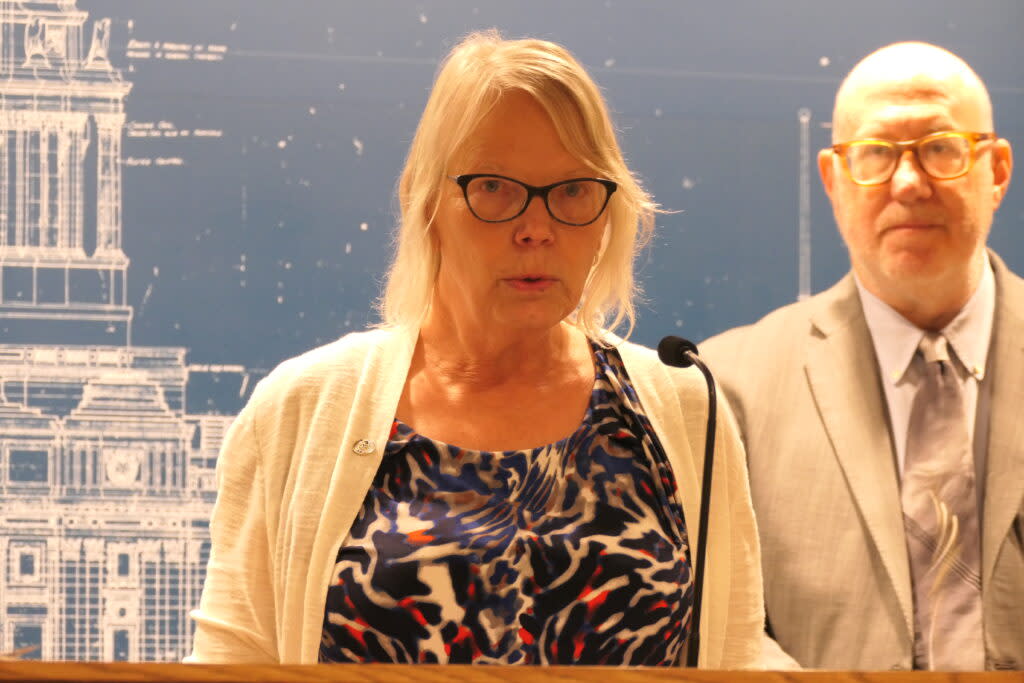Is burning wood or trash ‘carbon free’? The utilities want you to think so

- Oops!Something went wrong.Please try again later.
Rep. Liz Reyer, DFL-Eagan, speaks at a press conference on July 23, 2024, in support of a strict definition of "carbon-free" as the state considers how to eliminate carbon emissions from its electricity supply by 2040. Photo by Madison McVan/Minnesota Reformer.
A Minnesota law passed in 2023 directed the state’s utilities to generate all of their electricity from “carbon free” sources by 2040 — an aggressive goal meant to make Minnesota a leader in climate adaptation.
Now, regulators are grappling with how to implement the plan approved by DFL lawmakers and signed by Gov. Tim Walz while confronting intense lobbying by influential utilities seeking to protect profits. Much of the law’s execution is up to the Public Utilities Commission, a five-member committee appointed by the governor and charged with regulating the state’s energy providers.
Environmental organizations are adamant that regulators should stick to the definition of “carbon free” spelled out in the law: “a technology that generates electricity without emitting carbon dioxide.”
Energy companies, industry groups and some state leaders are pushing for the definition of “carbon free” to include carbon-emitting sources of energy like “woody biomass” — electricity generated by burning waste from logging and forest management operations; and anaerobic digestion, which captures gas emitted by decomposing organic waste.
In a public comment letter submitted to the PUC, the Minnesota Pollution Control Agency officials argued in favor of a “bigger picture view of emissions accounting.”
The PUC “should consider net emissions, in addition to gross emissions, from energy production technologies that have carbon emissions associated for the alternate handling of materials if they are not used in energy recovery processes,” the letter reads.
The MPCA argued, for example, that burning woody biomass should be allowed despite its carbon output because energy producers can implement measures to reduce or control emissions from burning the material. Whereas the alternatives — outdoor burns of plant waste, or leaving the waste to decompose — results in uncontrolled emissions releases.
Environmentalists — who recently attacked the Walz administration for being overly accommodating of industry — scoffed at the logic.
“Comments from utilities, agencies and industry are claiming that with some clever accounting, you could consider burning wood, trash or coal to be carbon free. These are preposterous claims that are antithetical to the spirit of the law,” said Andrea Lovoll, government relations director at Minnesota Environmental Justice Table, at a press conference Tuesday.
Utilities also want to be allowed to capture, compress and store or repurpose the carbon dioxide produced by fossil fuel and biomass power plants. In its public comment letter, Xcel Energy advocated for the use of such carbon capture and sequestration technologies.
But environmental advocates say the use of carbon-capture technology would create a loophole allowing the continued use of fossil fuels and biomass as an energy source.
“This law sets ambitious but necessary standards to achieve zero-carbon emissions from the energy sector for 2040 and it does so using clear and unambiguous language to define carbon free,” said state Rep. Liz Reyer, DFL-Eagan, who co-chairs the House Climate Action caucus. “Diluting the language opens the door to an array of false climate solutions.”
The public comment period for the PUC’s implementation of the zero-carbon energy law ends on July 24 at 5 p.m.
The post Is burning wood or trash ‘carbon free’? The utilities want you to think so appeared first on Minnesota Reformer.

